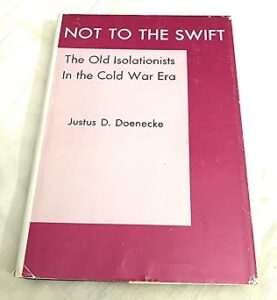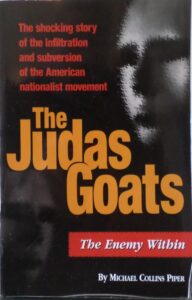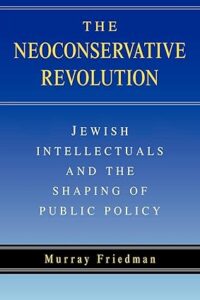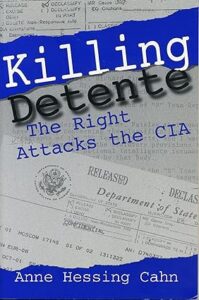Some books do more than educate—they change the direction of a person’s life.
For Michael Collins Piper, one such book arrived in his late teens and helped redirect his political worldview.
Prophets on the Right by Ronald Radosh, a left-wing author, provided unexpected clarity about the false dichotomy between “left” and “right” when it comes to American nationalism.
This book, and others like it, opened his eyes to the hidden hands guiding Cold War policies, conservative media, and foreign entanglements under the guise of patriotism.
What followed was a decades-long intellectual journey, grounded in nationalism and resistance to Zionist globalism.
The Book That Changed Everything
One of the most influential books in shaping Michael Collins Piper’s political outlook was Prophets on the Right: Conservative Critics of American Globalism by Ronald Radosh, published in 1976 by Simon & Schuster.
He first discovered this book at age 18. Over the years, he read it more than fifty times.
It was a cornerstone that eventually led him to work with Willis Carto.
The book profiles several historical figures Piper viewed as heroic.
These included Senator Robert A. Taft of Ohio, publisher Oswald Garrison Villard, historian Charles A. Beard, journalist John T. Flynn, and Lawrence Dennis—who would later become the subject of one of Piper’s own works.
Beyond World War II: Nationalists Who Rejected the Cold War
Radosh’s book didn’t just highlight their opposition to U.S. entry into World War II.
More importantly, it showed that these men—coming from both the political right and left—also opposed Cold War aggression.
Except for Flynn, they all questioned whether America’s hostile stance toward the Soviet Union truly served the national interest.
These were not communists, either in ideology or affiliation. Instead, they were American nationalists.
Radosh’s insights helped Piper question the anti-Soviet and anti-communist fervor popular among conservatives during the 1970s and 1980s.
He realized that this rhetoric was not always aligned with American values or national interest.
Charles A. Beard: A Voice for Non-Intervention and Self-Reliance
Among Nationalist, Charles A. Beard work stood out.
His works, A Foreign Policy for America (1940) and The Idea of National Interest (1934), both argued for U.S. non-intervention and national self-sufficiency.
Beard, once widely respected, was later shunned after challenging globalist narratives.
These books are essential reading for anyone interested in true American nationalism.
Unmasking Cold War Conservatism: Lessons from Doenecke’s Work
Another important book Piper found valuable was Not to the Swift: The Old Isolationists in the Cold War Era by historian Justus Doenecke (Associated University Press, 1979).
It supported and expanded on Radosh’s research.
This book showed how many America First advocates continued to resist foreign entanglements and Cold War politics.
Doenecke’s work revealed that much of the Cold War rhetoric was not nationalist—it was globalist.
He began to understand that many so-called “conservative” voices were in fact aligned with internationalist goals.
Some even supported Zionist aims, all under the mask of anti-communism.
The Buckley Cult: Media’s Role in Shaping Conservative Loyalty
In his younger years—before reading Prophets on the Right and Not to the Swift—Michael Collins Piper, like many who considered themselves conservatives, spent time studying prominent conservative voices.
One of the most influential was former CIA operative William F. Buckley Jr., whose magazine, National Review, was heavily promoted by the mainstream media as must-read material for conservatives.
Frankly, although Michael Collins Piper was never impressed with Buckley or his writings—now referred to by Piper as “writhings”—the media’s widespread promotion of Buckley was so strong that conservatives were essentially told they had to worship William F. Buckley Jr. to be considered true conservatives.
Many followed this path without question.
Trotskyites in Conservative Clothing: The Roots of Conservative Internationalism
As Michael Collins Piper explained in The Judas Goats, many prominent American Trotskyites rose to influence in the 1950s as leaders of a new form of “conservative internationalism.”
This ideology was promoted through William F. Buckley Jr.’s writings.
Numerous Jews and former Trotskyites were among Buckley’s associates at National Review, working diligently to, in their words, “cleanse” the American nationalist movement of what Buckley called “the fever swamps of anti-Semitism.”
One of the most notable figures promoted by Buckley was James Burnham.
Earlier in his career, Burnham was considered Leon Trotsky’s chief spokesman within American intellectual circles.
Learn why true American nationalism rejects endless wars and foreign entanglements in favor of peace, sovereignty, and the Founders’ vision.
Burnham’s Transformation and Wartime Role
When Stalin turned against the Trotskyites, James Burnham shifted his stance and became known as an “anti-communist liberal.”
This label was essentially a euphemism for what many considered the more accurate term: “Trotskyite.”
During World War II, Burnham worked for the Office of Strategic Services (OSS), the predecessor of the CIA, which was heavily influenced by Zionist and Trotskyite elements.
Burnham’s Aggressive Stance and His Critics
James Burnham, often praised as an intellectual, did more than criticize Stalinist Russia and American nationalists who sought to contain the Soviet Union.
He openly called for full-scale war against Russia. However, his aggressive position drew sharp criticism.
Notably, esteemed American historian Dr. Harry Elmer Barnes described Burnham’s fiery calls for war as “most dangerous and un-American.”
From Trotskyite to Conservative Leader: Burnham’s Lasting Influence
Despite—or perhaps because of—his controversial history, James Burnham transitioned into “Burnham the Conservative Leader” under the support of William F. Buckley Jr.’s National Review magazine.
For over twenty years, Burnham served as a key theoretical writer for the publication.
Though he passed away in 1987, his influence remains significant within Zionist, Trotskyite, and neo-conservative circles to this day.

The Religious and Intellectual Makeup of National Review
In The Neo-Conservative Revolution: Jewish Intellectuals and the Shaping of Public Policy (Cambridge University Press, 2005), Murray Friedman highlights an important detail about National Review.
Although one of Buckley’s close associates, Will Herberg, was an Orthodox Jew, Buckley regarded him as the “theological conscience” of the magazine.
Friedman also notes that, despite National Review often being seen as militantly Catholic and Irish Catholic, five Jews served on its original editorial board.
Trotskyite Roots Across the Political Spectrum
It is no coincidence that the American leftist journal Partisan Review—often seen as the counterpoint to Buckley’s National Review—supported Trotsky.
According to Murray Friedman, Partisan Review rejected liberalism because its editors believed too many liberals were pro-Stalinist.
Friedman also highlights that another well-known ex-Trotskyite, Dwight MacDonald, described this stance as a form of conservatism “expressed in a radical language,” noting that Partisan Review lacked a true conservative vocabulary.
Trotskyites’ Shift: From Radicalism to Conservative Influence
In other words, Trotskyites had effectively transformed into “conservatives,” despite not using traditional conservative language to express their views.
They found common ground with Buckley’s influential National Review, blending their ideas into the mainstream conservative movement.
Is there more information to include in this blog post?
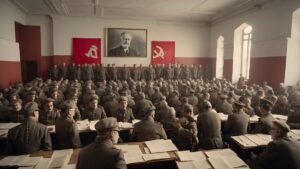
The Cold War Myth and Zionist Exploitation
Even today, many conservative groups—and some seemingly independent ones like the John Birch Society—cling to outdated Cold War rhetoric.
However, serious historians recognize that the Cold War was largely a fraud.
Hard-line Zionists seized on this false narrative to promote Israel as “our only democratic ally in the Middle East” and as a “bulwark against Soviet expansionism.”
Zionist Influence Behind the U.S. Military Buildup
Using this rhetoric, Zionist operatives—working through groups like the Committee on the Present Danger—pushed for a massive U.S. military buildup.
This was supposedly to counter Soviet “expansionism,” which by then was nearly nonexistent and largely a failing threat.
These provocateurs insisted that American security depended on arming Israel and supporting the Middle East state financially and otherwise to prevent Soviet global domination.
The High Priests of War: Exposing Zionist Manipulation
In his book The High Priests of War, Michael Collins Piper examined how the American system was manipulated by ex-Trotskyite Zionist forces playing a central role in this intrigue.
The foundation for this work came from the training he received from his late, beloved colleague at The Spotlight, Andrew St. George.
St. George was one of the first writers to expose the destructive actions of the “neo-cons,” writing extensively about them in The Spotlight starting in the early 1980s.
At that time, their activities were largely ignored, under-reported, or misunderstood by many who were focused on Zionist intrigues elsewhere.
Killing Detente: Behind the Neo-Conservative Rise
One important volume that complements Andrew St. George’s work is Anne Hessing Cahn’s Killing Detente: The Right Attacks the CIA (Pennsylvania State University Press, 1998).
This book offers valuable background on the behind-the-scenes actions of the warmongers and internationalists who later became known as the “neo-conservatives.”
Neo-Conservative Power and the Trillion-Dollar Defense Buildup
Anne Hessing Cahn’s book details how a network of figures like Richard Perle, Paul Wolfowitz, and Stephen Bryen—key members of a powerful Zionist bloc—rose to dominate the highest levels of U.S. policy making.
Their influence now extends through think tanks, publications, and groups strongly shaping the Republican Party.
Cahn explains the consequences of this manipulation of national security concerns:
“For more than a third of a century, perceptions about U.S. national security were colored by the view that the Soviet Union was on the road to military superiority over the United States.
Neither Team B nor the multibillion dollar intelligence agencies could see that the Soviet Union was dissolving from within.
For more than a third of a century, assertions of Soviet superiority created calls for the United States to ‘rearm.’
In the 1980s, this call was heeded so thoroughly that the United States embarked on a trillion-dollar defense buildup.
As a result, the country neglected its schools, cities, roads and bridges, and health care system.
From the world’s greatest creditor nation, the United States became the world’s greatest debtor, in order to pay for arms to counter the threat of a nation that was collapsing.”
From Cold War to War on Terror: A New Mask for the Same Agenda
Today, under the banner of fighting “terrorism” and “Islamic extremism,” the same ex-Trotskyite Cold Warriors have embraced a new internationalist agenda.
This modern push is viewed by Michael Collins Piper as merely a cover for Zionism and its broader goal of advancing the so-called New World Order.
According to Piper, what was once openly Trotskyite ideology has now been reshaped into a more subtle but equally dangerous form.
This transformed agenda presents itself as “Americanism,” though in truth, it stands in stark opposition to traditional American values.
Piper points to William F. Buckley Jr. as a key figure who helped clear the path for this shift in conservative thought.
Pat Buchanan’s Warnings on the Neo-Conservative Takeover
Two important books by Pat Buchanan offer deep insight into the rise of the neo-conservative agenda:
- A Republic, Not an Empire (Regnery, 1999)
- Where the Right Went Wrong: How Neoconservatives Subverted the Reagan Revolution and Hijacked the Bush Presidency (Thomas Dunne, 2004).
These works reflect Buchanan’s shift toward a nationalist perspective and his growing criticism of neo-conservative influence within the American right.
Buchanan’s Break from Cold War Conservatism
Although perhaps too sympathetic to Ronald Reagan’s legacy—understandable, given his role as a trusted advisor—Pat Buchanan’s books remain essential reading.
By the late 1990s, Buchanan had emerged as a bold voice for American nationalism.
He moved away from Cold War rhetoric and began challenging many of the mainstream conservative positions he once supported.
In doing so, Buchanan became one of the most effective voices—both intellectually and politically—for the traditional nationalism that Willis Carto had long defended, even as Buckley and the Trotskyites worked to erase authentic nationalists from the political stage.
Mainstream Voices for Nationalism: Buchanan and Ron Paul
Because Pat Buchanan has long been a mainstream public figure—despite many efforts to marginalize him—his work deserves recognition.
His visibility has allowed him to reach a much broader audience with his nationalist message than most others could.
In more recent years, the rise of the Ron Paul movement has also contributed to keeping elements of traditional American nationalism alive.
Though often viewed through a libertarian lens and not without its flaws, the movement has helped maintain a degree of nationalist thought in modern political discourse.
Discover the roots and revival of American populism and nationalism in our deep dive into how these movements challenge globalist power.
Reviving Real Nationalism in a Post-Neo-Conservative Era
The journey of Michael Collins Piper—from reading Prophets on the Right to working with Willis Carto—reveals a powerful transformation rooted in deep historical understanding.
Through critical works by authors like Ronald Radosh, Justus Doenecke, Charles A. Beard, and Anne Hessing Cahn, Piper uncovered the hidden threads connecting neo-conservatism, Zionism, and Cold War propaganda.
He showed how figures like William F. Buckley Jr. and James Burnham helped rebrand Trotskyite internationalism as “conservatism,” pushing real American nationalists to the fringes.
Voices like Pat Buchanan and the Ron Paul movement, have helped carry forward elements of true nationalism.
In a media landscape still influenced by Cold War echoes and internationalist agendas, Piper’s work challenges readers to reexamine what it means to be a nationalist—and whose interests are truly being served.



